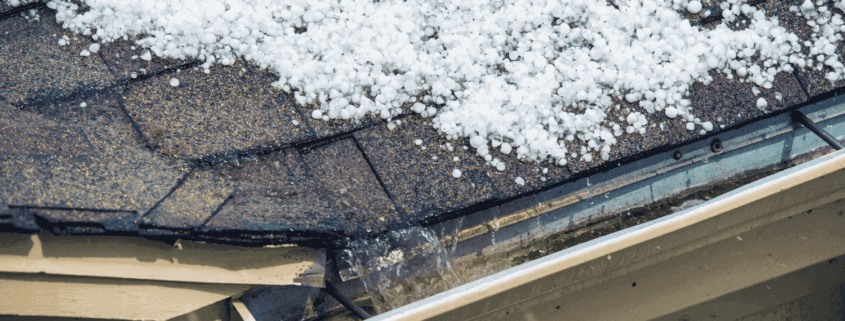What Does Hail Roof Damage Look Like?
What Does Hail Roof Damage Look Like?
So what does hail roof damage look like? Hail storms can wreak havoc on your roof, leaving it vulnerable to leaks and further issues. In this guide, we’ll show you how to spot the signs of hail damage on various roofing materials, such as asphalt shingles, wood shingles, and metal roofs, so you can take action before the damage worsens.
Key Takeaways
- Different roofing materials react uniquely to hail, making it essential to identify specific damage signs like dents, granule loss, and fractures quickly.
- Timely inspections by professional contractors after a hail storm can prevent further roof damage and ensure accurate insurance claims.
- Understanding your insurance policy regarding hail damage, including ACV and RCV coverage, is crucial for minimizing out-of-pocket costs during repairs.
Identifying Hail Damage on Different Roofing Materials
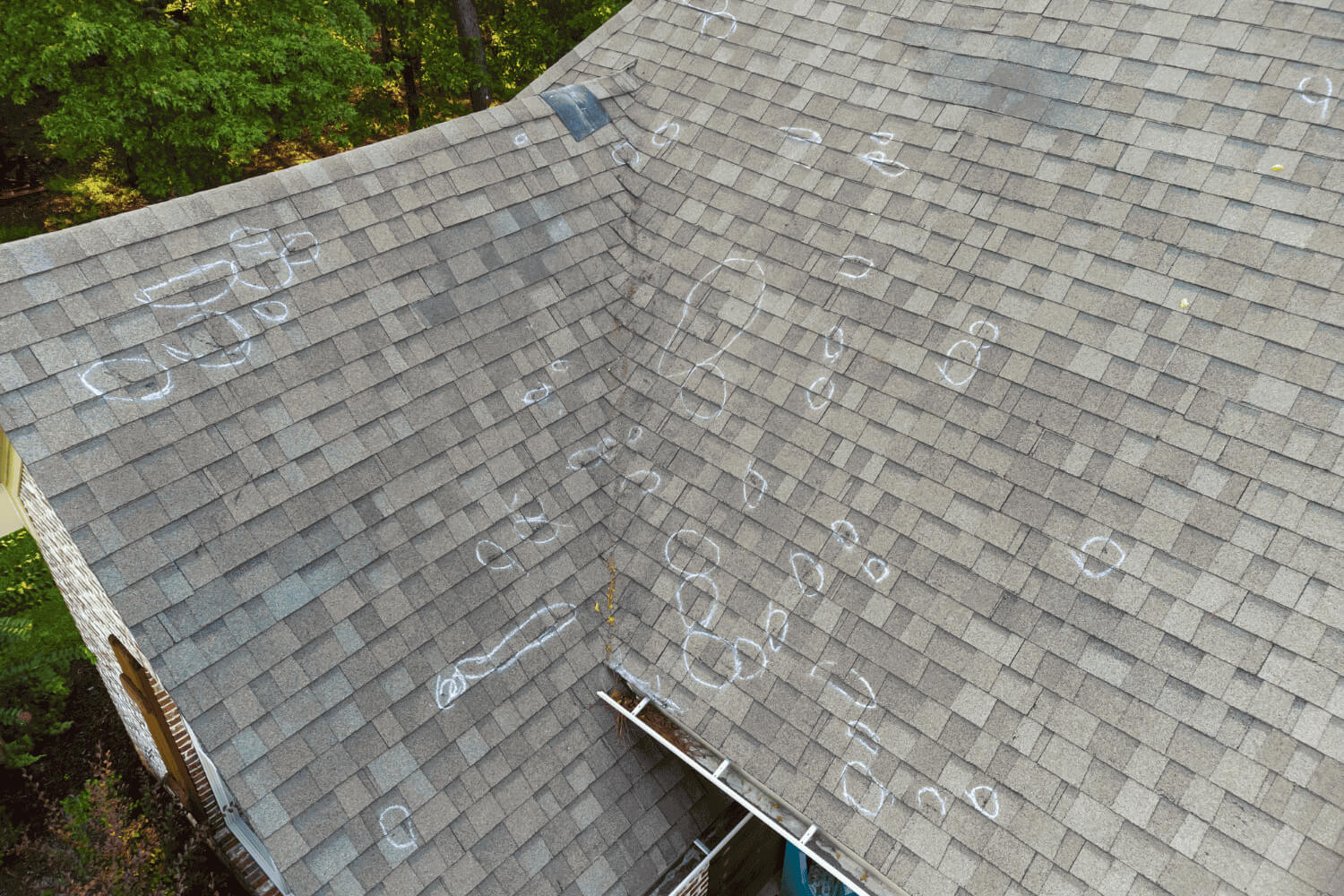
Hail storms can wreak havoc on roofs, but the damage they cause can vary significantly depending on the type of roofing material. Recognizing these differences allows for proper assessment and repair. Whether you have asphalt shingles, wood shingles, or metal roofing, understanding how hail impacts these materials will help you spot roof hail damage more effectively.
Each type of roofing material reacts differently to hail impacts. For instance, what might appear as a minor dent on a metal roof could be a significant crack on asphalt shingles. Understanding these distinctions helps accurately identify hail damage and determine the necessary repairs. This knowledge not only helps in maintaining your roof but also in filing accurate insurance claims.
Let’s delve deeper into how to identify hail damage on different roofing materials.
Asphalt Shingles
Asphalt shingles are a popular roofing material due to their cost-effectiveness and durability. However, they are not immune to the impacts of a hail storm. Common signs of hail damage on roof shingles include discoloration, small dark spots, cracks, and bald spots where granules have been knocked off. Hail can also cause bruises, holes, and fractures, weakening the shingles and making them more susceptible to further damage from UV exposure.
Addressing any observed damage promptly can prevent costly repairs later on.
Wood Shingles
Wood shingles offer a classic aesthetic but can suffer significantly in hail storms. Hail can cause various types of damage to wood shingles, including dents, splits, and splintering. Dents are typically on the surface, while more severe impacts lead to splits and splintering, compromising the shingles’ integrity.
Large hailstones can even crack or shatter dense wood shingles, necessitating immediate repairs to prevent water infiltration.
Metal Roofs
Metal roofs are known for their durability, but they are not completely impervious to hail damage. Common signs of hail damage on metal roofs include dents and punctures. While some dents might be purely cosmetic, significant impacts can cause punctures that lead to leaks.
If you suspect hail damage on your metal roof, having a professional assess the situation can help determine the extent of the hail roof damage and the necessary repairs.
Key Indicators of Hail Damage
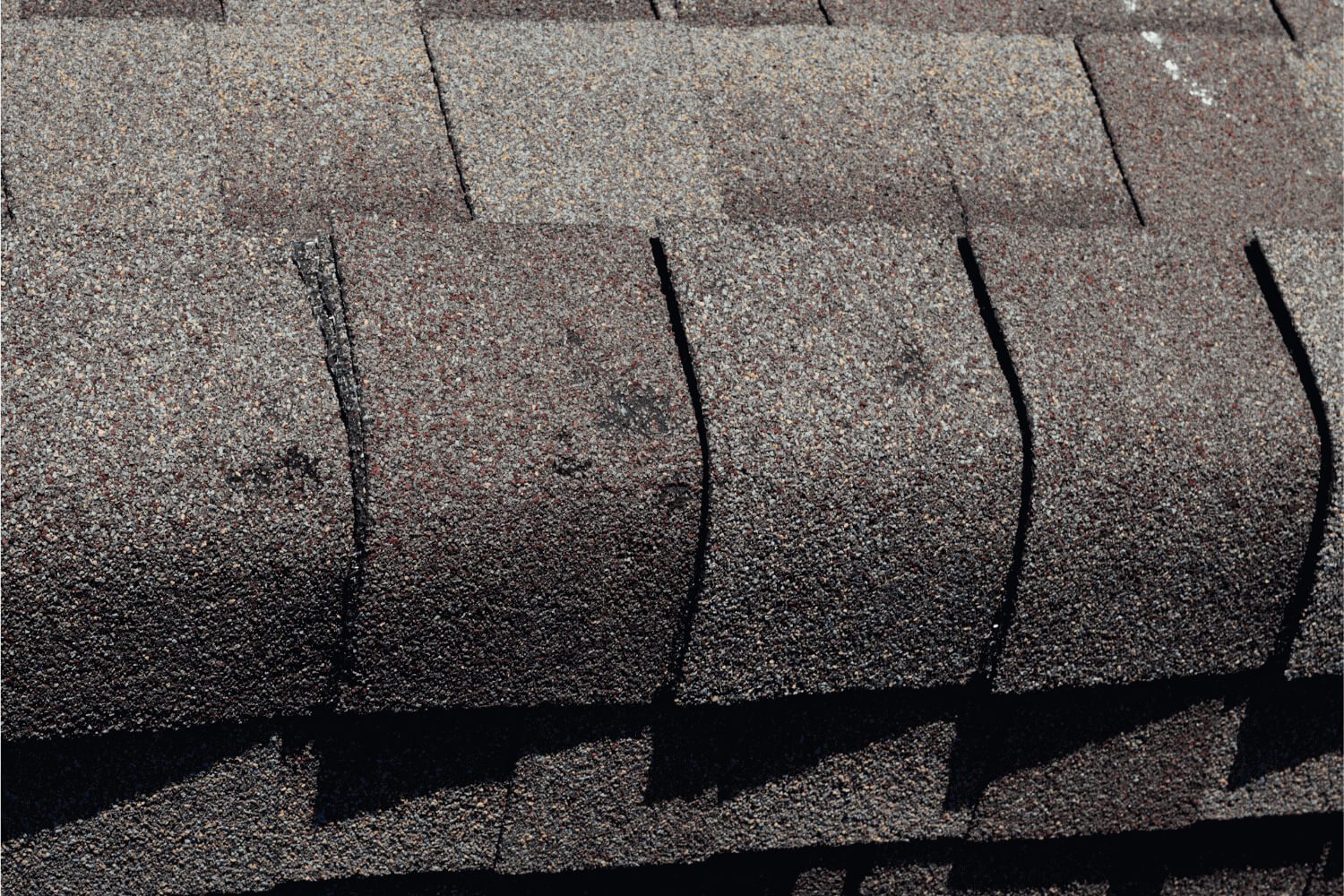
Identifying hail damage on your roof is not always straightforward, but certain key indicators can help you spot the signs. These indicators include dents, impact marks, granule loss, and cracked or broken shingles. Inspecting your roof thoroughly after a hail storm helps catch any damage early and address it promptly.
Inspecting not just the shingles but also roof vents, gutters, roof flashing, and other roof penetrations for hail damage is critical. Additionally, checking for signs of hail damage beyond the roof, such as dents in siding and outdoor items, can provide further clues. Recognizing these indicators helps identify hail damage more effectively, ensuring timely repairs and preventing further issues.
Let’s break down these key indicators in more detail.
Dents and Impact Marks
Dents and impact marks are some of the most evident signs of hail damage. These can appear as:
- Soft, bruise-like hits on the roof, indicating that the shingles have been compromised
- Random hits on asphalt shingles without a clear pattern
- Splits with distinct brown or orange coloration on wood shingles
While hail damage on metal roofs is often cosmetic, significant impacts can cause punctures. Noticing these dents and impact marks early can prevent further damage.
Granule Loss
Granule loss is another critical indicator of hail damage, especially on asphalt shingles. Hail impact can result in shiny patches and loss of granules, exposing the underlying asphalt to UV damage and increasing the risk of cracking and water leaks. An unusual amount of shingle granules in your gutters can also be a sign of hail damage.
This loss of granules can drastically affect the roof’s integrity and should be addressed promptly.
Cracked or Broken Shingles
Hail can cause significant damage to shingles, leading to cracks and breaks. These cracks can appear as splits with brown or orange coloration, indicating structural damage. Cracked or broken shingles can lead to potential leaks and further damage to the roof, making it crucial to repair or replace them as soon as possible.
Identifying and addressing these issues early can prevent more extensive and costly repairs later.
Factors Affecting Hail Damage Severity
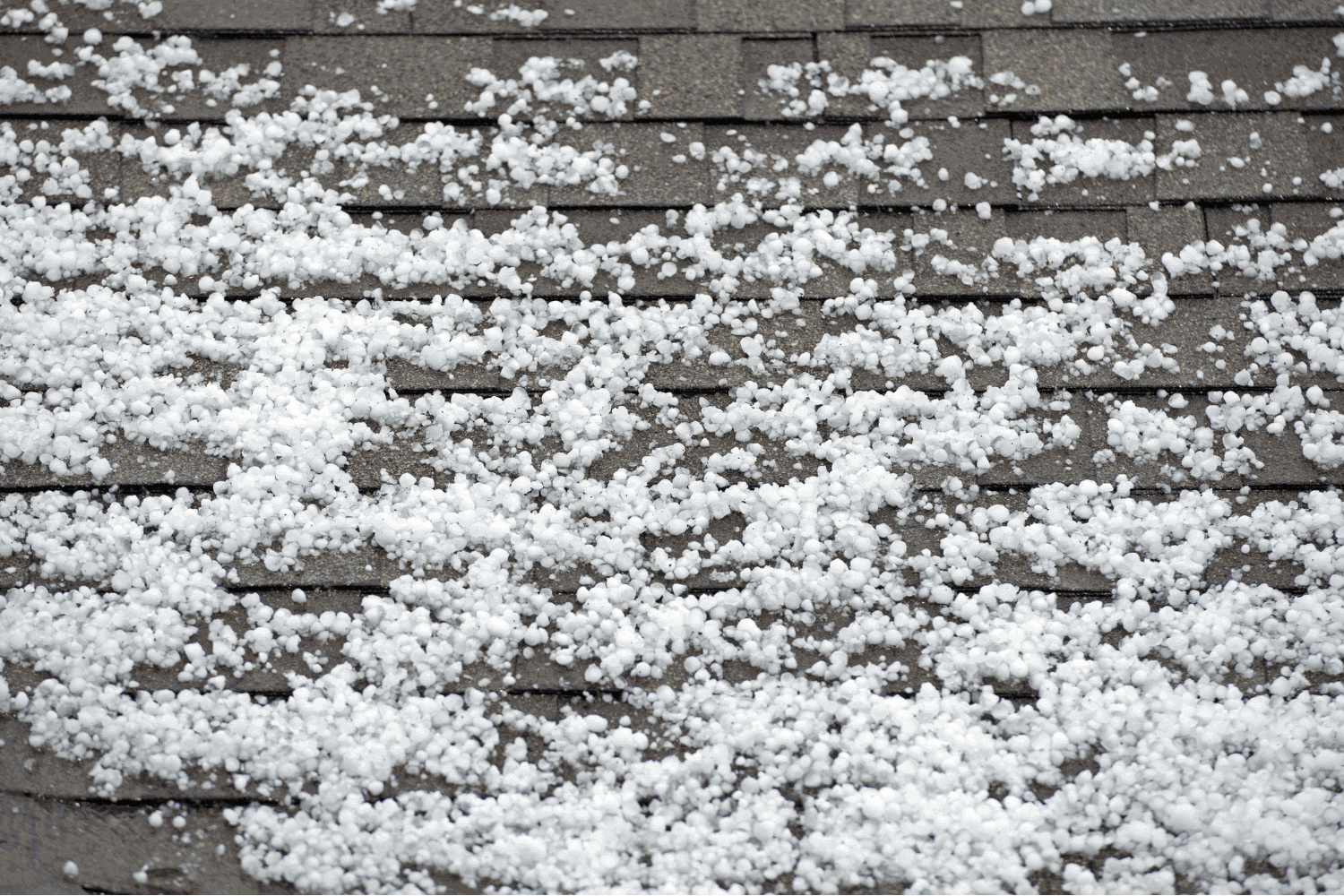
The severity of hail damage to your roof can be influenced by several factors, including the size and shape of the hail, wind speed and direction, and the age and condition of your roofing materials. Recognizing these factors can help you better prepare for and respond to hail damage.
Different roofing materials react uniquely to hail, affecting the appearance and extent of the damage. The combination of storm conditions and the current state of your roof plays a critical role in determining the severity of damage.
Let’s explore these factors in more detail.
Hail Size and Shape
Hailstones can vary significantly in size, ranging from tiny pellets to large baseball-sized stones. Hail over 1 inch in diameter is generally capable of causing noticeable damage to roofing materials. The impact speed of hailstones, which can range from 44 to 72 mph for sizes between 2 and 4 inches, also contributes to the potential for significant damage.
Recognizing the size and shape of hailstones can help gauge the potential damage to your roof.
Wind Speed and Direction
High wind speeds during a hail storm can significantly increase the severity of the damage inflicted on roofs. The wind direction can also play a crucial role in determining which parts of the roof are most affected. Wind-driven hail can cause more extensive damage, particularly on older or already compromised roofing materials.
Recognizing these factors helps identify the most vulnerable areas of your roof.
Roofing Material Age and Condition
The age and condition of your roofing materials are critical factors in determining their vulnerability to hail damage. Older roofing materials tend to be more susceptible to damage due to wear and degradation over time. Asphalt shingles with significant granule loss are more vulnerable to hail impacts. Similarly, wood shingles can split or splinter more easily if they have already experienced age-related deterioration.
Regular maintenance and timely repairs can mitigate these vulnerabilities.
Why Timely Roof Inspections Are Crucial
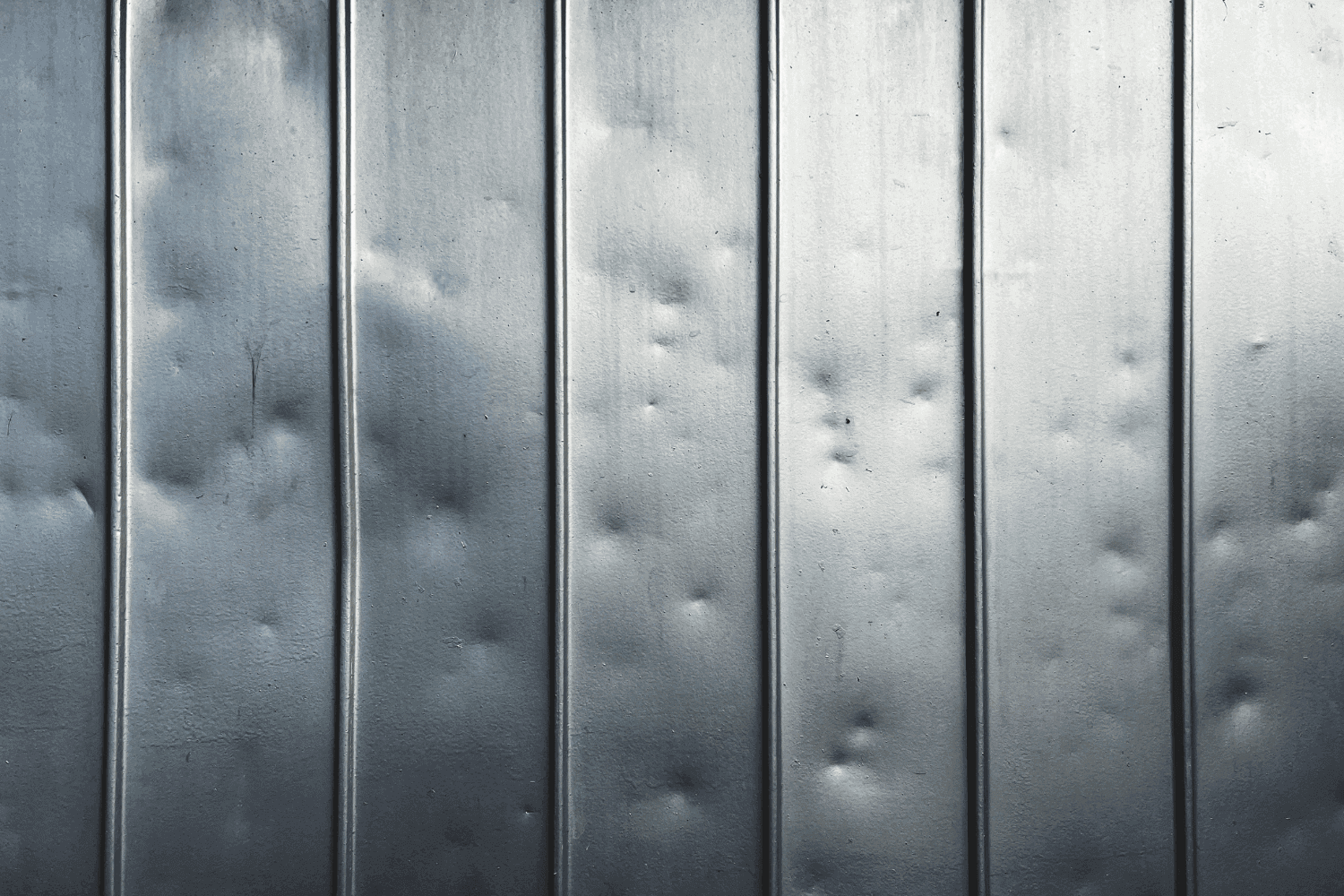
Timely roof inspections after a hail storm help identify damage that may not be immediately visible. These inspections help roofing professionals assess the extent of the damage and provide appropriate repair recommendations. Addressing minor damage quickly can prevent it from escalating into more significant problems and help avoid costly repairs.
Failing to inspect your roof after a hail storm can lead to water leaks inside the home, causing further damage and potentially leading to mold growth and structural problems. Acting quickly after roof damage is identified can prevent future leaks from minor issues.
The Role of a Professional Roofing Contractor
If you suspect hail damage on your roof, it is advisable to call a professional roofing contractor for inspection. Professional roofers have the expertise and equipment to conduct thorough inspections, covering all aspects of the roof, not just storm damage.
They also take photos of any damage for documentation and assessment, which is crucial for filing insurance claims. Hiring a professional ensures a comprehensive and safe inspection, potentially avoiding future headaches.
Insurance Claims
Timely roof inspections are crucial for insurance claims. Dents and impact marks on the roof surface are key indicators of hail damage that prompt inspections should identify. Having a contractor inspect the roof alongside the insurance adjuster is crucial, as insurance companies often look for reasons not to replace the roof.
Proper documentation, including photos and professional assessments, supports your claim and ensures appropriate coverage for repairs.
Repairing Hail-Damaged Roofs
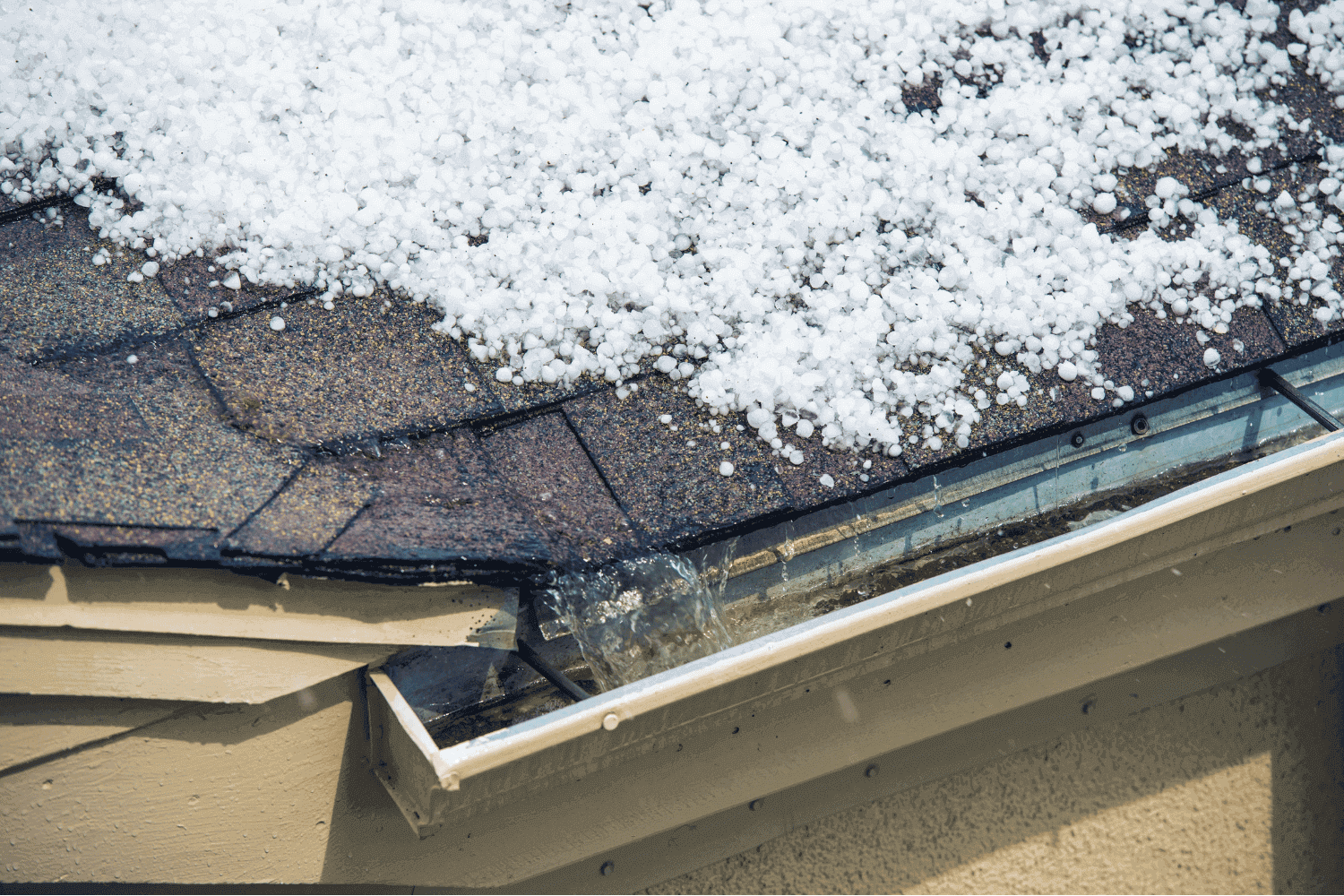
Repairing hail-damaged roofs promptly is essential to maintaining the integrity of your home. Neglecting hail damage can result in roof leaks and water damage. This raises the risk of costly interior damage, mold growth, and structural issues. Addressing hail damage promptly is crucial for maintaining roof integrity and may help avoid a complete roof replacement.
Depending on the severity of the damage, different repair options are available. Temporary solutions can provide immediate protection, while more extensive damage may require a full roof replacement. Let’s explore these repair methods in more detail.
Temporary Solutions
Temporary solutions can be effective in protecting your roof from further damage until permanent repairs are completed. Covering damaged areas with a tarp can prevent leaks. Roofing cement can seal small leaks temporarily, protecting the interior from water damage.
Roofing tape is another quick way to patch minor cracks and holes in shingles until more permanent solutions are available. These measures can provide immediate relief and buy time for more comprehensive repairs.
Full Roof Replacement
Extensive hail damage may necessitate a full roof replacement to ensure structural integrity and prevent future leaks. If the damage compromises the roof’s protective ability, replacing the entire roof might be the best option.
A professional roofing contractor can assess the damage and recommend whether a full replacement is required, ensuring your home remains safe and secure.
Does Insurance Cover Hail Damage?
Most homeowners’ insurance policies cover hail damage, but it’s crucial to review your specific policy to understand the coverage details. Not all insurance policies provide the same level of coverage, so knowing what your policy includes is essential to avoid unexpected expenses.
Knowing your insurance policy can help you navigate the claims process more effectively. Insurance policies for hail damage generally fall under two categories: Actual Cash Value (ACV) and Replacement Cost Value (RCV). Knowing the difference between these types of coverage can significantly impact your out-of-pocket costs.
Understanding Your Policy
Insurance policies covering hail damage typically fall under two categories: Actual Cash Value (ACV) and Replacement Cost Value (RCV) policies. An ACV policy provides the depreciated value of the hail-damaged roof, meaning you receive a payout based on the current value of your roof, not its replacement cost.
In contrast, an RCV policy covers the full cost to replace the roof with a new one, ensuring you receive enough to cover the entire cost of a new roof, minus your deductible. Knowing these differences is crucial when reviewing your policy, as it affects your out-of-pocket costs after a hail storm.
Filing an Insurance Claim
Filing an insurance claim for hail damage involves several steps to ensure you receive the coverage you deserve. Start by taking detailed photos of the damage for documentation. Next, obtain estimates from licensed contractors to support your claim and provide a realistic picture of repair costs.
Most insurance policies allow up to one year to file a claim for hail damage, so acting promptly is important. Having a professional roofing contractor inspect the damage alongside the insurance adjuster can also help ensure that all damage is accurately assessed and properly documented.
Summary
In conclusion, identifying and addressing hail roof damage promptly is vital to maintaining the integrity of your home. Understanding how hail impacts different roofing materials, recognizing key indicators of damage, and knowing the factors that affect the severity of the damage can help you take swift action. Timely roof inspections by a professional roofing contractor are crucial for spotting damage early and filing effective insurance claims. Whether you need temporary repairs or a full roof replacement, addressing hail damage quickly can prevent further issues and save you from expensive future repairs. Stay proactive, keep your roof in top condition, and ensure your home remains safe and secure.
Frequently Asked Questions
What are common signs of hail damage on a roof?
If you notice dents, impact marks, granule loss, or cracked shingles on your roof, it’s likely showing signs of hail damage. Addressing these issues promptly can save you from more extensive repairs down the line!
How can I tell if my roof needs a full replacement?
A full roof replacement is necessary if you notice extensive hail damage like widespread cracks, punctures, or significant granule loss. Take action now to protect your home!
Does my homeowners’ insurance cover hail damage?
Yes, most homeowners’ insurance policies cover hail damage, but it’s crucial to review your policy to ensure you’re fully protected. Take the time to understand your coverage and stay prepared!
What should I do immediately after a hail storm?
Immediately after a hail storm, check your roof for damage. If damage is found, take photos for documentation and reach out to a professional roofing contractor. Acting quickly can save you from costly repairs down the line!
How can I find a reliable roofing contractor?
To find a reliable roofing contractor, focus on those with positive reviews, proper licenses, and recognized certifications like GAF Master-Elite®. Ask for referrals from friends or family and check for complaints with the Better Business Bureau to ensure you’re making a trustworthy choice.
 574-318-3326
574-318-3326


